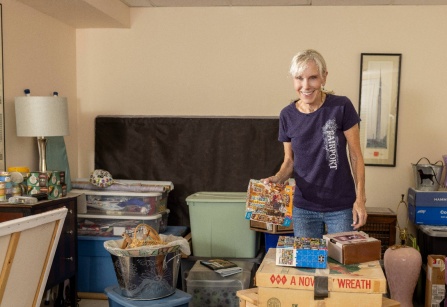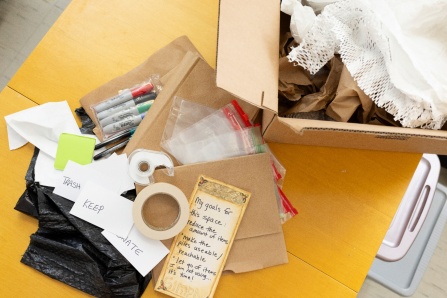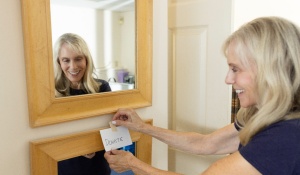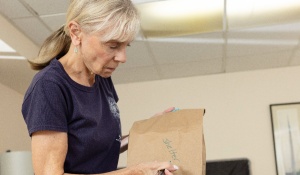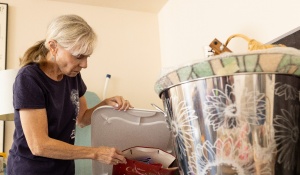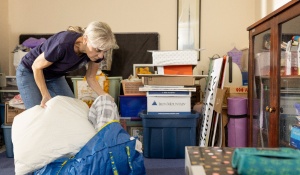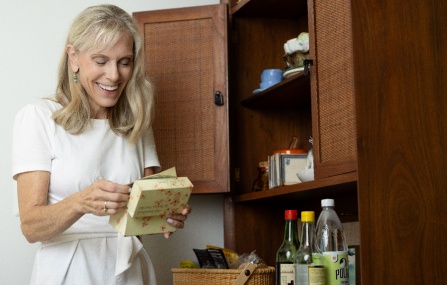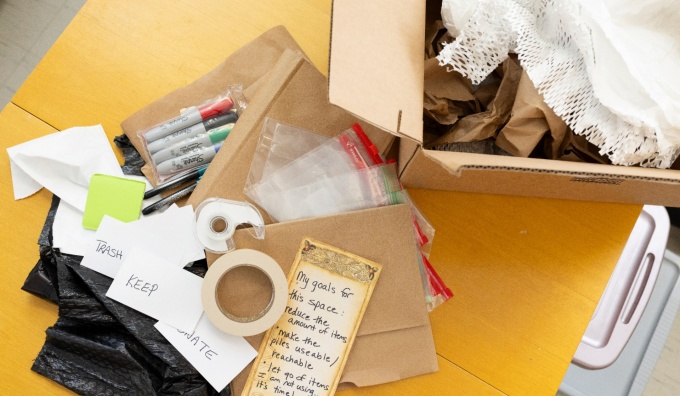
Take Care
By Catherine Donnelly

Cindy German, MSW ’08, owner, Finding Space. Photos: John Schlia
Cindy German, MSW ’08, founded her professional organization business, Finding Space, as a side hustle over a decade ago. After she moved a few times, she realized she liked streamlining her own things and helping friends reorder their living spaces too. Last year, the business became her full-time job.
The most common situations that German helps people manage are unexpected deaths or a medical crisis that necessitates downsizing. “No one plans to collect so many things,” she says. “Life gets busy and suddenly someone is alone in a huge house filled with memories and stuff and needs to move.”
German hopes that by planning ahead, she can help people feel more prepared when tragedy strikes.
“It is hard to confront a lifetime of memories by yourself,” she says. “I enjoy this work and the process of getting to know someone, helping them process grief or other trauma and reframe their memories. I know I was born to be a social worker.”
While German uses her trauma-informed skills to help her clients, anyone can follow this process to declutter and refresh well-used spaces.
— Cindy German, MSW ’08
Get started decluttering
Assess
Before you tackle a space (your garage, closet, room or even a drawer) take time to evaluate the situation. German recommends that you set a goal, so you know when you’ve succeeded: “I ask clients what they expect to see when we are done. We write that down and refer to it regularly to keep us on track.”
- Are there piles of paperwork? You only need to keep three years of taxes and one year of bills.
- Are there duplicates? People often buy multiples of items they are afraid of not having when they need them, like paper products or guest items.
- Are there obviously damaged items? Removing them could open up space quickly.
Prepare zones
When you are ready to start, set up four zones: keep, donate, recycle and toss. “The zones are important for making decisions about where objects are going,” German explains. “Everything you touch needs to be placed into a zone when you are done looking at it.”
- Markers, tape, sticky notes, boxes and bags are essential.
- You may need gloves and masks if a space is moldy or animals have access to it.
- Label the zones clearly.
Sort
With a goal in mind, begin to touch each object. German says this is where a friend or helper is important because you can talk about things, have assistance moving heavy items and get permission to throw something away.
“Every item you saved was important to you once,” she says. “But you really want to keep items that help you move forward, not keep items that leave you stuck or blocked. This is why donating items is so important. Your items can still be loved.”
- Look at everything! Important papers can be misfiled. Special objects may be buried.
- Try to keep moving and not get stuck. If you start to freeze while considering an object, move on to something else.
- Take a break when needed.
Organize
When you’ve completed the sorting, put your keep pile back in a sensible order. “For small spaces, the reset may be simple. Larger spaces can take time, and this is where a professional organizer can help you,” German says. “Being able to enjoy your treasures is a wonderful thing.”
- Clear the zones as quickly as you can. If it is trash or a donation, take it out right away to avoid the temptation to change your mind.
- Review if your goal was achieved.
- Celebrate the experience.
